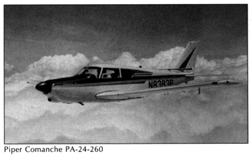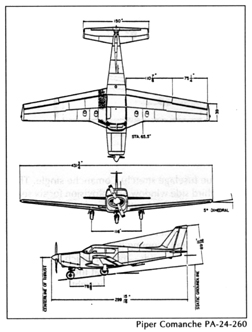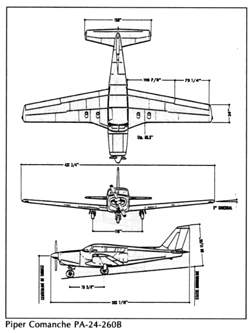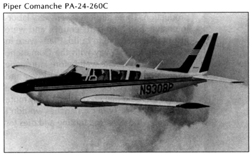Comanche 260 series, including:
PA-24-260
(1965)
PA-24-260B
(1966 to 1968)
PA-24-260C
(1969 to 1972)
PA-24-260TC
(1970 to 1972)
With the 260 series, we start to diverge from the basic Comanche
idea in that these airplanes become more complex and the original Comanche
design is significantly altered. Even so, a total of 1,029 airplanes were
sold from the Comanche 260 line. These souped-up versions offered more
power (260 hp) and speed from the 250's O-540 - in the straight 260, thanks
to a 125-rpm increase in propeller redline (2,700 rpm, as opposed to the
250's 2,575 rpm); in the B and C models due to fuel injection and aerodynamic
improvements; and in the TC with the addition of dual manually controlled
Rajay turbochargers. Some 38 straight 260s came with carbureted engines.
The rest were fuel-injected. Recommended TBOs stayed at 2,000 hours for
all engine variants.
|
|
The straight 260 was the lightest
of the pack, with an empty weight of approximately 1,700 pounds and a gross
weight of 2,900 pounds. Like its predecessors, it has four seats and a few
have carbureted engines. And like the rest of the Comanche singles, a 90-gallon-capacity
auxiliary fuel system was available as an option. Cruise speeds ranged
from 142 to 161 knots, fuel burns ran from 13 to 19 gph, and ranges with
IFR reserves go from 950 nm (90-gallon fuel system, 55 percent power, at
15,000 feet) to 550 nm (60-gallon fuel system, 75 percent power, at 8,000
feet). Full-fuel payloads ranged from 660 to 740 pounds. The 260 could
climb well, too: 1,500 fpm at gross weight under standard conditions. New,
they usually sold for approximately $30,740.
The 260B is the first "stretched" (by six inches over previous models,
thanks to a longer prop spinner not a true fuselage stretch) Comanche single.
They have a third side window and provision for six seats, although the
fifth and sixth seats are suitable only for children and rob a lot of space
from the baggage compartment. Fuel injection is standard in the B, which
uses the Lycoming IO-540 of 260 hp. Empty weight is 1,728 pounds - most
of which is explained by a soundproofing package that included thicker, double-paned
windows. Gross weight was upped to 3,100 pounds, and useful loads rose 172
pounds - to 1,372 pounds - over that of the straight 260. Because of the extra
weight, cruise speeds dropped three knots or so from the straight 260's values,
but with the fuel injection came a reduction in fuel burns. These ran from
11 to 14 gph; ranges with IFR reserves go from 1,000 nm (90-gallon fuel system,
55-percent power, at 15,000 feet) to 550 nm (60-gallon fuel system, 75-percent
power, at 8,000 feet). Maximum rate of climb is posted at 1,370 fpm under
gross weight, standard conditions. New, 260Bs cost from $32,820 to $33,820. |
|
The 260C was the first really modern-looking
Comanche single. It brought with it the advent of the 'Tiger Shark" cowling,
another 100-pound hike in gross weight, cowl flaps, an aileron-rudder interconnect,
multiengine-style power quadrant, and standard - T display of flight instruments.
Its 1,427pound useful load is the highest of all the Comanches, including
the twins, and is second only to the Comanche 400. Cruise speeds range
from 150 to 161 knots, fuel flows from 12.5 to 14.1 gph, and ranges with
IFR reserves from 870 nm (90-gallon fuel system, 55-percent power, at 15,000
feet) to 550 nm (60-gallon fuel system, 75-percent power, at 8,000 feet).
Actually, the Tiger Shark cowling was not for looks alone. To prevent possible
aft center of gravity problems due to the 260C's increased gross weight and
its fifth and sixth seats, the propeller shaft was extended. This alteration
moved the center of gravity slightly forward, which nipped the CG problem
in the bud and made for a nice-looking cowl in the bargain. (Rumor has it
that famed designer Ed Swearingen was responsible for the sleek-looking cowls,
a variation of which were also adapted for use from the Twin Comanche's graceful
cowlings.) When new, average-equipped 260Cs sold for between $36,550 and $45,990. |
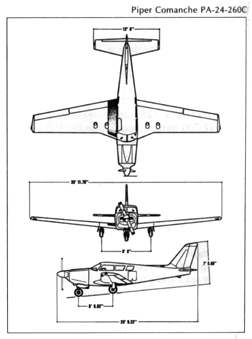 The 260-TC, or Turbo C, is the hot rod of the 260 series. It has a turbo
normalizing system with what Piper called a "second throttle" on the power
quadrant. The procedure for using this manually controlled turbocharger was
to first use throttle to bring manifold pressure up to a desired level.
If conditions are such that insufficient manifold pressure is developed for
the task at hand, then the drill is to begin closing the turbo's wastegate
by moving the turbocharger lever forward. This raises manifold pressure to
values as high as 29 inches MAP at altitudes up to 25,000 feet. In this way,
the "second throttle" can make up for the adverse effects of high-density
altitude. The turbo lever must be moved slowly to avoid sudden, inadvertent
over-boosting. With full turbocharger and a power setting of 25 inches MAP,
2,400 rpm, and 15 gph, the TC could turn in a true airspeed of 198 knots at
25,000 feet. At 12,000 feet, the TC could still turn out 178 knots using
27 inches MAP, 2,400 rpm, and 15 to 17 gph. Range with the 90-gallon tanks
could reach 1,000 nm with IFR reserves. Gross weight is 3,200 pounds, useful
load is 1,306 pounds, and if you really had the need for speed, you could
crack open the turbo at optimum altitude and achieve 210 knots. New, the
TC sold for between $46,375 and $51,720.
The 260-TC, or Turbo C, is the hot rod of the 260 series. It has a turbo
normalizing system with what Piper called a "second throttle" on the power
quadrant. The procedure for using this manually controlled turbocharger was
to first use throttle to bring manifold pressure up to a desired level.
If conditions are such that insufficient manifold pressure is developed for
the task at hand, then the drill is to begin closing the turbo's wastegate
by moving the turbocharger lever forward. This raises manifold pressure to
values as high as 29 inches MAP at altitudes up to 25,000 feet. In this way,
the "second throttle" can make up for the adverse effects of high-density
altitude. The turbo lever must be moved slowly to avoid sudden, inadvertent
over-boosting. With full turbocharger and a power setting of 25 inches MAP,
2,400 rpm, and 15 gph, the TC could turn in a true airspeed of 198 knots at
25,000 feet. At 12,000 feet, the TC could still turn out 178 knots using
27 inches MAP, 2,400 rpm, and 15 to 17 gph. Range with the 90-gallon tanks
could reach 1,000 nm with IFR reserves. Gross weight is 3,200 pounds, useful
load is 1,306 pounds, and if you really had the need for speed, you could
crack open the turbo at optimum altitude and achieve 210 knots. New, the
TC sold for between $46,375 and $51,720.
